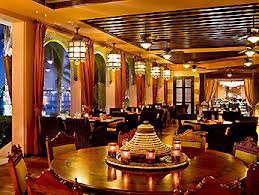
One of La Palmeraie’s unique assets is the breathtaking Nile view. The restaurant is situated in Sofitel Cairo El Gezirah and has an indoor section where you can enjoy the splendid view through the restaurant’s large windows and an outdoor section where shisha and drinks are served.
The spacious restaurant is tastefully decorated with wooden tables, colourful Moroccan tagines, oriental rugs, and luxurious chandeliers.
The waiters, dressed in crimson shirts decorated with traditional golden embroidery, approached us with smile which they wore until the end of the meal. As soon as we sat down a variety of bread including Moroccan, brown baguette and olive bread appeared on the table. The fresh and tasty bread was served with three choices of savoury dips, olives, sliced pickled lemons, and harissa, a red sauce made of spicy chilli and herbs. A warning is in order: the harissa is very spicy!
While we were still enjoying the fresh bread, the waiter served us five different salads and explained the ingredients of each.
The zaalouq is an aubergine salad served with tomato sauce and topped with sesame seeds. Those out there who love pepper would really enjoy the shakshooka, sliced bell pepper with a strong taste of garlic. The green salad tasted like an average green salad but the vegetables were really fresh and the potato salad was rather delicious. The chopped artichoke salad lacked taste, which was disappointed.
Next a round, gold dish arrived on our table. After showing it to us the waiters took it away to cut it in four quarters and we were served with what appeared to be a chicken pie… except there was something sweet about it.
The chicken pastillya, a classic Moroccan dish served at weddings, is made of small, tender chicken pieces mixed with cinnamon, garlic, lemon, onion, saffron, ginger, toasted almonds, parsley, coriander and icing sugar. The mixture is then wrapped in phyllo pastry and baked. Once out of the oven, icing sugar is sprinkled on top and it is ready to be served.
We were particularly excited about this dish as it promised an oriental version of sweet and savoury food. And the result was not disappointing. The crisp pastry, coupled with the tender chicken, offered an intriguing contrast of textures.
Next we tried three different main dishes; lemon chicken with olives, lamb with prunes, and couscous with vegetables. The dishes were served in colourful tagines. The chicken was boned at the table and accompanied by black olives. The chicken was cooked to perfection, but the olive taste smothered it completely. As a whole the dish had a strong sour taste, coupled with a touch of citrus.
The lamb was very tender and was cooked with prunes, ginger, saffron, cinnamon, honey, sugar and ground cinnamon; again creating a sweet, deep flavour.
The couscous was perhaps the most conventional of the main dishes and La Palmeraie did not go wrong with this classic Moroccan dish. The couscous was fresh and not sticky, but the vegetables, including carrots, potatoes and zucchini, were sautéed and rather tasteless.
The restaurant’s chef Deiaa Abu Shmamma said couscous is one of the most popular main dishes served. “Egyptians are afraid of trying the sweet and savoury dishes at first,” she said. “But once they try them, they come back for more.”
We mixed the couscous with the lamb sauce to give it a richer flavour. A small dish of tfaya was also served with the main dish, which helped turn the conventional couscous into another exotic dish. Tfaya is a Moroccan garnish, consisting of caramelised onion served with raisins, honey, ginger, almonds, saffron and cinnamon, usually served as a couscous topping. La Palmeraie offers it as a side dish, giving customers the freedom to add it to taste.
Abu Shmamma told us her grandfather was a confectioner, so we had a lot of expectations regarding the desserts but they were not as tasty as the main dishes.
We tried the ktefa, made of golden, crispy, layered phyllo sheets with a mixture of milk mixed with starch, eggs and orange peel in between the layers. It tasted OK, but the milky liquid tasted too much like muhallabieh.
Next we were treated to different Moroccan biscuits. The biscuits are variations of ghorayebahs, an oriental biscuit cooked with an almond paste. Some of the biscuits had sugar sprinklings on top, others, such as the gazelle horns, did not. They more or less all tasted the same and were nothing special.
Abu Shamamma said when she agreed with the hotel management to start the restaurant, the agreement was to try it for four months. “We have been open for six years… we are a group that loves the work,” she said.



